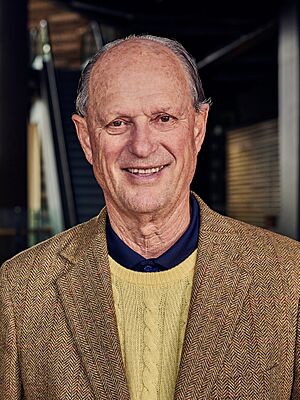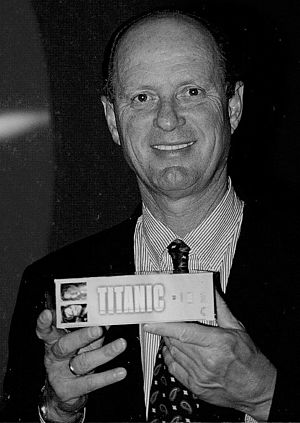Robert Ballard facts for kids
Quick facts for kids
Robert Ballard
|
|
|---|---|

Ballard in 2023
|
|
| Born |
Robert Duane Ballard
June 30, 1942 Wichita, Kansas, U.S.
|
| Education | University of California, Santa Barbara (BS) University of Hawaiʻi at Mānoa (MS) University of Rhode Island (PhD) |
| Employer | University of Rhode Island Graduate School of Oceanography |
| Known for | Ocean exploration and underwater archaeology; discoveries of the wrecks of the RMS Titanic, the battleship Bismarck, the aircraft carrier USS Yorktown, and John F. Kennedy's PT-109 |
| Awards | Kilby International Awards (1994) The Explorer Medal (1995) Hubbard Medal (1996) Caird Medal (2002) |
| Military career | |
| Allegiance | United States |
| Service/ |
|
| Years of service | 1965–1995 |
| Rank | |
Robert Duane Ballard, born on June 30, 1942, is an American ocean explorer. He was also a Navy officer and is now a professor at the University of Rhode Island. He is famous for his work in underwater archaeology, which is like being a detective for shipwrecks.
Ballard is best known for finding the wrecks of the famous RMS Titanic in 1985. He also discovered the German battleship Bismarck in 1989 and the aircraft carrier USS Yorktown in 1998. In 2002, he found the wreck of John F. Kennedy's boat, PT-109. He even met the islanders, Biuku Gasa and Eroni Kumana, who saved its crew.
Besides shipwrecks, Ballard also discovered hydrothermal vents. These are special places deep in the ocean where life thrives using chemicals, not sunlight. He once said finding these vents was even more exciting than finding the Titanic! Ballard also started the JASON Project, which helps students learn about science and exploration. He leads ocean explorations on his research ship, the E/V Nautilus.
Contents
Early Life and His Journey to the Ocean
Robert Duane Ballard was born in Wichita, Kansas, on June 30, 1942. When he was two, his family moved to southern California. His father worked as an engineer there. Robert became interested in exploring the ocean after watching the 1954 movie 20,000 Leagues Under the Sea. This film was based on a book by Jules Verne.
While in high school, his father helped him connect with oceanographers. These scientists worked at the Scripps Institution of Oceanography. Robert even joined them on some short research trips. He later went to the University of California, Santa Barbara. There, he studied chemistry and geology.
In 1967, while studying for his PhD, he was called to serve in the military. He asked to join the US Navy as an oceanographer. The Navy then sent him to work with the Woods Hole Oceanographic Institution. After leaving active duty in 1970, he continued to work at Woods Hole. He helped get funding for undersea research using a special submarine called Alvin. In 1974, he earned his PhD in marine geology from the University of Rhode Island.
Military Service and Ocean Exploration
Ballard joined the United States Army Reserve in 1965. In 1967, he transferred to the US Navy as an oceanographer. This allowed him to combine his military service with his passion for the ocean. He retired from the Navy as a Commander in 1995.
His first dive in a submersible was in 1969. It was in the Ben Franklin off the coast of Florida. In 1970, he started mapping the Gulf of Maine for his studies. He used sound waves to understand the ocean floor. He also used the submersible Alvin to collect rock samples.
Discovering Deep-Sea Vents
In 1974, Ballard was part of Project FAMOUS. This project explored the Mid-Atlantic Ridge, a mountain range under the ocean. In 1977, during an exploration near the Galapagos Islands, Alvin found something amazing. They discovered deep-sea hydrothermal vents. These vents were surrounded by unique living creatures. These creatures got their energy from chemicals, not sunlight. This was a huge discovery for biology!
In 1979, the RISE project found even more vents. These were on the East Pacific Rise near Mexico. Scientists saw black "smoke" coming out of these vents. Ballard and another scientist, Jean Francheteau, went down in Alvin. They measured the temperature of these "black smokers." It was incredibly hot, about 350 degrees Celsius (662 degrees Fahrenheit)!
Finding Famous Shipwrecks
Ballard was always interested in shipwrecks. He helped develop small, unmanned submersibles. These robots could be controlled from a ship and had cameras and arms. He saw these robots as a way to find the Titanic.
The Titanic Discovery

In the summer of 1985, Ballard was searching for the Titanic. He was on the French research ship Le Suroît. Later, he moved to the R/V Knorr from Woods Hole. The U.S. Navy secretly funded this trip. They wanted Ballard to first find two missing Navy submarines. These were the USS Scorpion and the USS Thresher.
Ballard and his team found that the submarines had broken apart under the ocean's immense pressure. This left thousands of pieces of debris on the seafloor. Following these debris trails helped them find the submarines. Ballard realized the Titanic likely broke apart in a similar way. So, he used his robot, Argo, to search for a debris trail.
In the early morning of September 1, 1985, they saw strange things on the ocean floor. First, small craters, then debris. Finally, they saw a boiler, and soon after, the hull of the Titanic! Ballard's team explored the outside of the wreck. They confirmed it had split in two. He believed the site was a cemetery and did not remove any artifacts.
On July 12, 1986, Ballard returned to the Titanic wreck. This time, he used Alvin and a smaller robot called Jason Junior. Jason Junior could fit into small openings to see inside the ship. They took many detailed photos of the wreck. In 1988, Ballard wrote a book about his discovery. It was called Discovery Of The Titanic: Exploring The Greatest Of All Lost Ships.
Other Famous Wrecks
Finding the Bismarck
In 1989, Ballard and his team searched for the German Battleship Bismarck. It sank off the coast of France. The Bismarck was much deeper than the Titanic. Ballard used an ocean-crawling robot to find it. He wanted to know if the British sank it or if its crew scuttled (sank) it. Ballard later wrote a book about this search, The Discovery of the Bismarck.
Exploring the Lusitania
In 1993, Ballard investigated the wreck of the RMS Lusitania off the Irish coast. This ship was hit by a torpedo. Ballard found no evidence of a boiler explosion. He thought coal dust inside the ship might have caused a second, larger explosion. He wrote a book about this, Exploring the Lusitania: Probing the Mysteries of the Sinking that Changed History.
World War II Wrecks
In 1992, Ballard explored many World War II wrecks in the Pacific. He found the wreck of the IJN Kirishima. His book Lost Ships of Guadalcanal shows many ships sunk in Ironbottom Sound. On May 19, 1998, Ballard also found the wreck of the Yorktown. This aircraft carrier sank during the Battle of Midway. It was found three miles (5 km) deep.
John F. Kennedy's PT-109
In 2002, Ballard and the National Geographic Society found parts of John F. Kennedy's boat, PT-109. This boat was rammed in 1943 by a Japanese destroyer. Ballard's visit also highlighted the islanders, Biuku Gasa and Eroni Kumana, who saved the crew.
Exploring the Black Sea
Ballard also explored the Black Sea. Scientists thought that ancient ships might be well-preserved there. This is because the deep waters of the Black Sea have very little oxygen. Without oxygen, organisms that usually destroy wood cannot survive.
Ballard's team found ancient shorelines and river valleys underwater. They also discovered three ancient shipwrecks near Sinop. One wreck, named "Sinop D," was found at a depth of 320 meters (about 1,050 feet). It was incredibly well-preserved. Its entire hull and cargo were intact. Even its mast, rising 11 meters (36 feet) into the water, was still there! This wreck was about 1,500 years old.
These discoveries helped scientists learn about ancient trade routes and shipbuilding. The Black Sea expeditions showed how well organic materials can be preserved in its deep, oxygen-free waters.
Awards and Recognition
Robert Ballard has received many awards for his amazing work:
- In 1994, he received the Kilby International Award.
- In 1995, he was given The Explorer Medal.
- In 1996, he received the Lone Sailor Award for his naval service and underwater archaeology.
- In 2002, he was awarded the Caird Medal.
- An asteroid, 11277 Ballard, was named in his honor in 2002.
- He received the National Humanities Medal in 2003.
Teaching and Inspiring Others
In 2004, Ballard became a professor of oceanography at the University of Rhode Island. He also directs the Institute for Archaeological Oceanography there.
The JASON Project
In 1989, Ballard started the JASON Project. This is a special program that uses technology to teach middle school students about science. He created it because he received thousands of letters from students after he found the Titanic. He wanted to inspire young people to get excited about science and exploration.
Personal Life
Robert Ballard is married to Barbara Earle. He has three sons and one daughter.
See also
 In Spanish: Robert Ballard para niños
In Spanish: Robert Ballard para niños
- Center for Ocean Exploration and Archaeological Oceanography
- German battleship Bismarck
- JASON Project
- Mystic Aquarium
- USS Yorktown
- Wreck of the RMS Titanic

